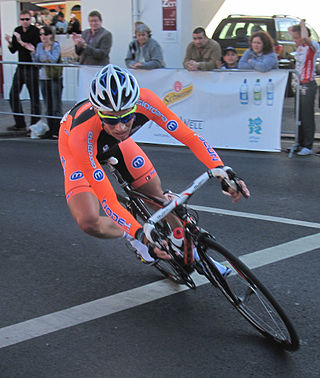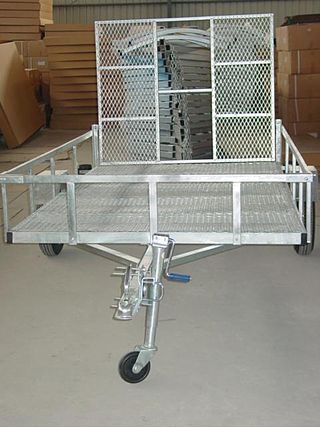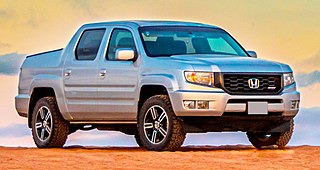Related Research Articles

An anti-lock braking system (ABS) is a safety anti-skid braking system used on aircraft and on land vehicles, such as cars, motorcycles, trucks, and buses. ABS operates by preventing the wheels from locking up during braking, thereby maintaining tractive contact with the road surface and allowing the driver to maintain more control over the vehicle.

Steering is the control of the direction of motion or the components that enable its control. Steering is achieved through various arrangements, among them ailerons for airplanes, rudders for boats, cylic tilting of rotors for helicopters, and many more.

Electronic stability control (ESC), also referred to as electronic stability program (ESP) or dynamic stability control (DSC), is a computerized technology that improves a vehicle's stability by detecting and reducing loss of traction (skidding). When ESC detects loss of steering control, it automatically applies the brakes to help steer the vehicle where the driver intends to go. Braking is automatically applied to wheels individually, such as the outer front wheel to counter oversteer, or the inner rear wheel to counter understeer. Some ESC systems also reduce engine power until control is regained. ESC does not improve a vehicle's cornering performance; instead, it helps reduce the chance of the driver losing control of the vehicle.
A traction control system (TCS), is typically a secondary function of the electronic stability control (ESC) on production motor vehicles, designed to prevent loss of traction of the driven road wheels. TCS is activated when throttle input and engine power and torque transfer are mismatched to the road surface conditions.

The Ford Explorer is a range of SUVs manufactured by Ford Motor Company since the 1991 model year. The first five-door SUV produced by Ford, the Explorer was introduced as a replacement for the three-door Bronco II. As with the Ford Ranger, the model line derives its name from a trim package previously offered on Ford F-Series pickup trucks. As of 2020, the Explorer became the best-selling SUV of all time in the American market.

A trailer is an unpowered vehicle towed by a powered vehicle. It is commonly used for the transport of goods and materials.

The Ford Expedition is a full-size three-row SUV, manufactured and marketed by Ford over four generations since model year 1997, deriving directly from Ford's concurrent generations of its F-150 pickup truck—and marketed since 2007 in regular and extended lengths, the latter replacing the Ford Excursion. Since 1997, Ford's Lincoln brand has marketed a rebadged variant of the Expedition, as the Lincoln Navigator.

Advanced driver-assistance systems (ADAS) are technologies that assist drivers with the safe operation of a vehicle. Through a human-machine interface, ADAS increase car and road safety. ADAS use automated technology, such as sensors and cameras, to detect nearby obstacles or driver errors, and respond accordingly. ADAS can enable various levels of autonomous driving.

Electronic brakeforce distribution or electronic brakeforce limitation (EBL) is an automobile brake technology that automatically varies the amount of force applied to each of a vehicle's wheels, based on road conditions, speed, loading, etc, thus providing intelligent control of both brake balance and overall brake force. Always coupled with anti-lock braking systems (ABS), EBD can apply more or less braking pressure to each wheel in order to maximize stopping power whilst maintaining vehicular control. Typically, the front end carries more weight and EBD distributes less braking pressure to the rear brakes so the rear brakes do not lock up and cause a skid. In some systems, EBD distributes more braking pressure at the rear brakes during initial brake application before the effects of weight transfer become apparent.

The Honda Pilot is a mid-size crossover SUV with three-row seating manufactured by Honda since 2002. Primarily aimed at the North American market, the Pilot is the largest SUV produced by Honda. Pilots are currently manufactured in Lincoln, Alabama, and the Pilot was produced in Alliston, Ontario until April 2007. The first generation Pilot was released in April 2002 as a 2003 model.
Power steering is a system for reducing a driver's effort to turn a steering wheel of a motor vehicle, by using a power source to assist steering.

A tow hitch is a device attached to the chassis of a vehicle for towing, or a towbar to an aircraft nose gear. It can take the form of a tow ball to allow swiveling and articulation of a trailer, or a tow pin, or a tow hook with a trailer loop, often used for large or agricultural vehicles where slack in the pivot pin allows similar movements. Another category is the towing pintle used on military vehicles worldwide.

Towing is coupling two or more objects together so that they may be pulled by a designated power source or sources. The towing source may be a motorized land vehicle, vessel, animal, or human, and the load being anything that can be pulled. These may be joined by a chain, rope, bar, hitch, three-point, fifth wheel, coupling, drawbar, integrated platform, or other means of keeping the objects together while in motion.

Brake-by-wire technology in the automotive industry is the ability to control brakes through electronic means, without a mechanical connection that transfers force to the physical braking system from a driver input apparatus such as a pedal or lever.

Vehicle safety technology (VST) in the automotive industry refers to the special technology developed to ensure the safety and security of automobiles and their passengers. The term encompasses a broad umbrella of projects and devices within the automotive world. Notable examples of VST include geo-fencing capabilities, remote speed sensing, theft deterrence, damage mitigation, vehicle-to-vehicle communication, and car-to-computer communication devices which use GPS tracking.

A collision avoidance system (CAS), also known as a pre-crash system, forward collision warning system (FCW), or collision mitigation system, is an advanced driver-assistance system designed to prevent or reduce the severity of a collision. In its basic form, a forward collision warning system monitors a vehicle's speed, the speed of the vehicle in front of it, and the distance between the vehicles, so that it can provide a warning to the driver if the vehicles get too close, potentially helping to avoid a crash. Various technologies and sensors that are used include radar (all-weather) and sometimes laser (LIDAR) and cameras to detect an imminent crash. GPS sensors can detect fixed dangers such as approaching stop signs through a location database. Pedestrian detection can also be a feature of these types of systems.
Honda Advanced Technology is part of Honda's long-standing research and development program focused on building new models for their automotive products and automotive-related technologies, with many of the advances pertaining to engine technology. Honda's research has led to practical solutions ranging from fuel-efficient vehicles and engines, to more sophisticated applications such as the humanoid robot, ASIMO, and the Honda HA-420 Honda-jet, a six-passenger business jet.
Crosswind stabilization (CWS) is a relatively new advanced driver-assistance system in cars and trucks that was first featured in a 2009 Mercedes-Benz S-Class. CWS assists drivers in controlling a vehicle during strong wind conditions such as driving over a bridge or when overtaking a semi-truck. CWS uses yaw rate, lateral acceleration, steering angle, and velocity sensors to determine how much assistance to give the driver in a certain scenario whether it be at different speeds or while turning. Using different components throughout the vehicle like brakes, differentials, and suspension, CWS can implement the readings from force sensors to properly assist the driver in a given situation.

The Honda Ridgeline (YK1) is the first generation of pickup truck manufactured by Honda for North America. According to some automotive journalists, the first generation Ridgeline has some noteworthy designs, including:

The Honda Ridgeline (YK2/YK3) is the second generation of pickup truck manufactured by Honda under the Ridgeline nameplate. The second generation Ridgeline took a different approach in design from the first generation Ridgeline by using Honda's new "global light truck platform," found in the third generation Honda Pilot as well as other large Honda vehicles, and made modifications such as:
References
- ↑ Trailer Sway Control Demonstration, srwhite on YouTube, 22 September 2006. Accessed 20 January 2017.
- 1 2 Trailer Stability Assist, Honda New Zealand. Accessed 7 November 2024.
- ↑ TRAILER STABILITY, Right Connections (UK). Accessed 7 November 2024.
- 1 2 Trailer Stability Assist, Skoda Vehicles. Accessed 7 November 2024.